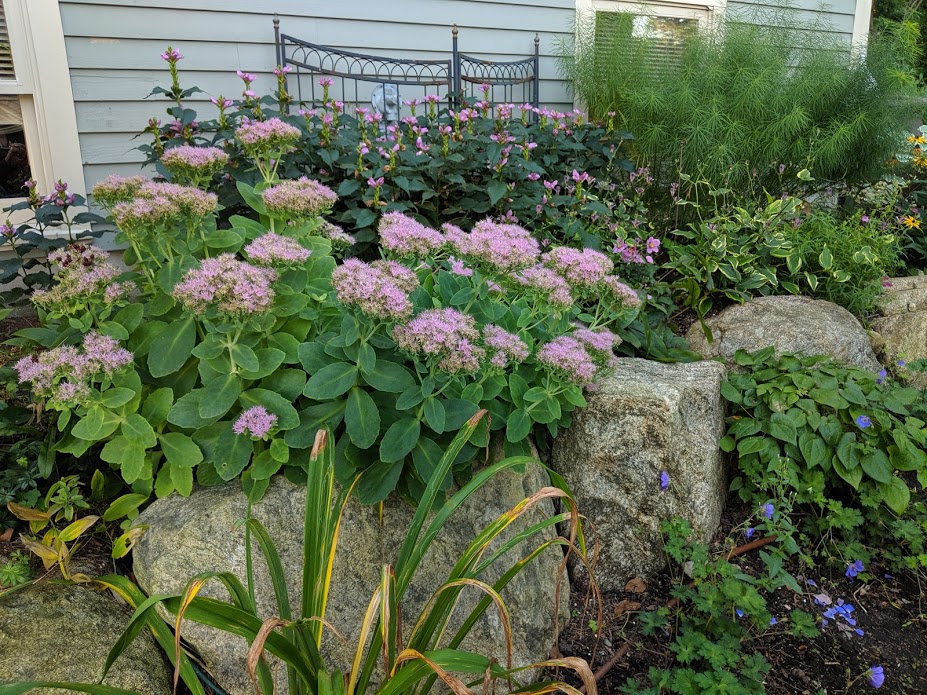October Garden Tips - Yellowing Pine Needles - Want to Pump Up the Drama Next Year?
Fall is rapidly descending upon our gardens here in Southern NH. Chilly nights and clear crisp days are lovely, but many plants are showing the telltale “end of season” signs. Browning foliage, flopping sedum, yellowing needles. For inexperienced gardeners, some of these signs can be alarming. I’m here to reassure you that there’s probably no cause for concern. Instead, embrace the decline and help ease your garden into the coming winter.
Sudden Yellowing of Evergreen Needles
This is probably the most alarming. You’ve just planted that gorgeous white pine or cypress, and suddenly you notice a LOT of yellow needles. Rest assured, this is normal behavior for many conifers (pine, spruce, fir, arborvitae). Conifers shed their older needles at this time of year and healthy specimens will regenerate new growth next spring. Here’s a reliable source with more information that should help allay any fears! I just took these photos of some of my prized conifer specimens showing interior needle yellowing and drop. The white pine species are the most notable needle shedders, dropping old needles annually. (click and hover for more information on each plant):
I fully expect that all will have recovered with fresh interior needle “sprouts” by next spring. However, as I mentioned a few days ago, it’s still very important to give these guys a good soaking a few times before the ground freezes. This is especially important for trees that have been planted within the last 2-3 years. The extra watering attention will help sustain them through sunny winter days when they will be prone to moisture loss through transpiration. Important tips:
Trees and shrubs should ideally receive one inch of water per week.
Note: the light rain showers of the past few nights are NOT sufficient to deeply water our gardens.
Double Note: overhead watering from lawn sprinkler systems is not only insufficient, it can be harmful to our garden plantings. Instead, install drip irrigation that delivers water slowly and directly to the root ball.
White pine needlecast damage
Come spring time, I will be sure to remove the dead interior needles in the densest of the specimens above to permit good air circulation. This is especially necessary with the ‘Merrimack’ white pine which is so full and dense that many of the needles remain stuck in the interior of the tree.
It is important to understand the difference between “normal” annual needle drop which affects older, interior needles and “needlecast” which affects newer needles. The latter definitely indicates a potential problem with the tree, and should not be ignored. Here’s a great UNH article on the subject.
preserve habitat for wildlife
If you decide to tidy up a bit this fall, please consider leaving valuable habitat for over-wintering insects and other wildlife. My mantra is always “a messy garden is a life-sustaining garden”. There are many plants that provide essential shelter for wild birds and small mammals and should not be cut back in the fall. These include fountain grasses and Japanese forest grasses, as well as climbing vines: honeysuckle, climbing hydrangea and clematis.
The following photos were taken at the end of September and depict the beauty of ornamental grasses and flowering vines in the early Fall garden. Furthermore, these examples will all retain their beauty through winter snow and ice. I won’t even touch the following plants until next April as they will help sustain birds and insects this winter (click and hover for more information on each plant):
Plants to punch up the excitement for next fall
Even if you can’t plant any more this season, NOW is the time to begin planning and dreaming for next Fall’s garden. Observe the current state of plant combinations and identify areas that could benefit from better foliage and bloom next year. Documenting “holes” or problems in the garden now will make plant shopping next spring SO much easier.
Ask yourself, “could this area benefit from: purple foliage, more height, delicate texture, bold leaves, pink, purple, yellow, orange, red, white?”, and make notes as you take photos. Then use your notes and images to begin your shopping list for next spring.
I am relying more and more on Pinterest boards when trying to visualize plant combinations. I create “wish list” and “idea list” boards and actual “this is what I bought and need to figure out where to plant” list boards like this one.
When selecting plants for your garden, try to focus on those that provide four seasons of interest and habitat. Many gardens are the weakest in the Fall because our focus tends to be on spring and summer color once plant shopping season begins. And perennials that deliver high drama in Fall don’t necessarily look that great in the nursery pot in Spring. So, it’s helpful to know in advance what you’re in for with these late season beauties!
Here are some of my favorite plants for beauty and pollinator interest from September through November here in New England (click and hover for more information on each plant):
If you would like help planning improvements to your garden for 2020, please reach out. I’ll be designing a number of gqrdens over the winter and would be happy to share ideas! Many of my plant recommendations are not typically available at retail nurseries or garden centers. You can read more about how I source native and unusual perennials here. I look forward to chatting about your garden!




















